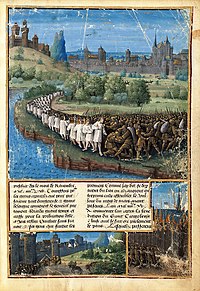Peasants' Crusade
| People's Crusade | |||||||
|---|---|---|---|---|---|---|---|
 The defeat of the People's Crusade |
|||||||
|
|||||||
| Belligerents | |||||||
|
West European Catholics Armenian Kingdom of Cilicia |
Seljuk Turks | ||||||
| Commanders and leaders | |||||||
|
Walter Sans Avoir Peter the Hermit |
Kilij Arslan | ||||||
| Strength | |||||||
| 20,000 Crusaders (initially 40,000) |
Unknown | ||||||
| Casualties and losses | |||||||
| Extremely high; near-complete destruction | Relatively low | ||||||
The People's Crusade was the prelude to the First Crusade and lasted roughly six months from April to October 1096. It is also known as the Peasants' Crusade, Paupers' Crusade or the Popular Crusade as it was not part of the official Catholic Church-organised expeditions that came later. Led primarily by Peter the Hermit with forces of Walter Sans Avoir, the army was destroyed by the Seljuk forces of Kilij Arslan at Civetot, northwestern Anatolia.
Historically, there has been much debate over whether Peter was the real initiator of the Crusade as opposed to Pope Urban II. The expedition's independence has been used by some historians such as Hagenmeyer to prove this.
Pope Urban II planned the departure of the crusade for 15 August 1096; a number of unexpected bands of peasants and low-ranking knights organized and set off for Jerusalem on their own. The peasant population had been afflicted by drought, famine, and disease for many years before 1096, and some of them seem to have envisioned the crusade as an escape from these hardships. Spurring them on had been a number of meteorological occurrences beginning in 1095 that seemed to be a divine blessing for the movement: a meteor shower, aurorae, a lunar eclipse, and a comet, among other events. An outbreak of ergotism had also occurred just before the Council of Clermont. Millenarianism, the belief that the end of the world was imminent, popular in the early 11th century, experienced a resurgence in popularity. The response was beyond expectations: while Urban might have expected a few thousand knights, he ended up with a migration numbering up to 100,000 Crusaders of mostly unskilled fighters, including women and children. The list of known Crusaders who fought with Peter can be found in Riley-Smith, et al, A Database of Crusaders.
...
Wikipedia
